JHP Newsletter - 2014, No. 3, 22 September
Greetings from western Colorado where I'm photographing the fall color with Jan. It seems like a long time has passed since the last Newsletter, and a lot of that time wasn't spent making great images.
Travel: Swift Foxes, Pawnee National Grassland, Colorado
Jan and I spent 17 days in the Pawnee National Grassland in northeastern Colorado at the end of May and the beginning of June to photograph swift foxes. We found a pretty nice den for photography, but the vixen was extremely skittish. It took her many days to get used to us, but fortunately, the dog, or male, wasn't very concerned about us and brought the kits out early on.
Here's the dog (below L) resting by the den shortly after we found the den. A few days later, two of the kits started to spend some time out of the den (below R). The image also shows that the dog (L) and vixen (R) were quite affectionate.
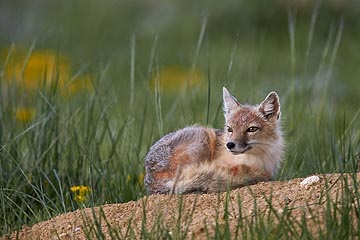
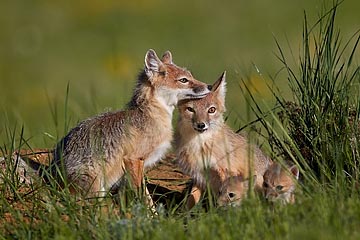
Three days after that, the two oldest kits started to play with each other (below L). The dog was quite tolerant of the rambunctious kits too (below R).
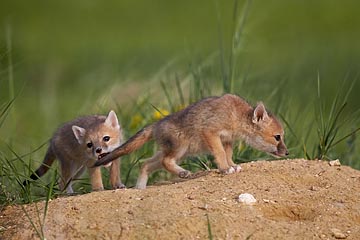
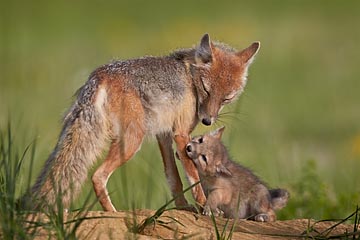
A few days later, the kits became even more energetic as they played (below L). Beginning around this time, the dog was no longer seen regularly at the den, possibly because all of the kits were now spending some time out of the den and the vixen could leave to hunt for herself. The final image (below R) shows all five of the kits with the vixen, and the oldest kit has entered the stage when they discover that an open mouth can be quite intimidating.
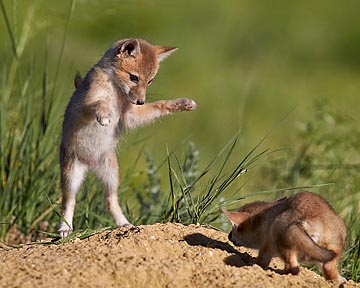
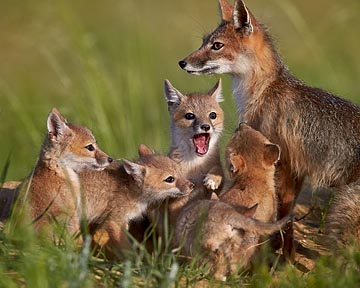
Travel: Wildflowers, San Juan National Forest, Colorado
In the middle of July, I spent ten days in the San Juan National Forest in the high country of western Colorado to photograph the wildflowers. The wildflower bloom was significantly affected by the heavy snowfall during the winter. In areas where there had been snow cover late into the summer, the flowers were either late blooming or nonexistent. Fortunately I was able to find some nice patches of flowers for photography, and I tried to make images that were different than I've made before.
I photographed this Old Man of the Mountain or Alpine Sunflower (below L) near an Alpine lake and included some of its environment. Blue Columbine or Colorado Columbine (below R) is the Colorado State Flower, and I liked how this blossom and bud were surrounded by Giant Red Paintbrush, Scarlet Paintbrush, or Indian Paintbrush. Usually I would avoid such a distracting background for a flower portrait, but here the paintbrush provided an interesting pattern for the background. By using a fairly large aperture (f5.6), I was able to blur the paintbrush slightly to help the columbine stand out. Second, I used a 90mm Tilt/Shift lens so I could align the plane of focus through the bloom and the large bud after positioning the camera to get the best arrangement of the paintbrush behind the columbine.
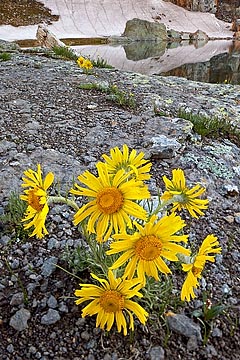

I made many intimate landscapes, those between flower portraits and grand landscape images, and this one (below L) with Rosy Paintbrush or Split-Leaf Indian Paintbrush and Alpine Avens or Ross's Avens among boulders is a favorite. I only made one typical grand landscape image (below R), and it almost didn't happen. I had scouted the area the day before and there was a nice patch of wildflowers along the small tarn and the forecast was for calm winds at dawn. Well, at dawn, it was breezy enough that the flowers were bobbing all around and someone had tromped through the wildflowers I had planned to put in the foreground. The clouds were pretty good, so I set up and did the best I could with the untrampled flowers in the foreground. The clouds kept getting better and better and I was able to capture this image when most of the flowers were stationary.

0.3 sec, f16, ISO 100
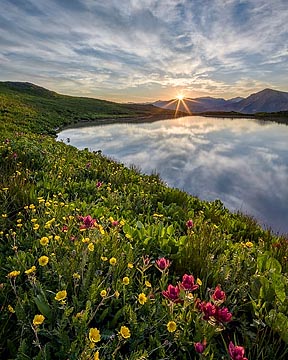
1/250, 1/125, 1/60, 1/30, 1/15, 1/8, & 1/4 sec; f16; ISO 100
I also spent a lot of time with a group of eight Yellow-Bellied Marmot pups that were probably from two different litters. Here (below L), one of the pups is interacting with an adult. One afternoon while I was photographing the pups, I saw an adult marmot working its way towards my Jeep and I knew it would go through a nice patch of Alpine Avens or Ross's Avens to get there. I also knew that it was interested in my Jeep because on the previous days I had seen one and sometimes two adult marmots climbing around my Jeep looking for something tasty to chew on like wires or hoses. I got into position to photograph the adult, and it kept on coming towards the Jeep and it didn't mind me shooing it away from the Jeep and at one point I had a hard time getting it out from under the Jeep. Because the marmot was so tolerant, I switched to a fairly wide-angle lens for wildlife, a 45mm Tilt/Shift lens. Because the marmot was so intent on getting to my Jeep and also quite tolerant of me, I was able to corral it into a nice setting for a fantastic grand landscape image (below R).

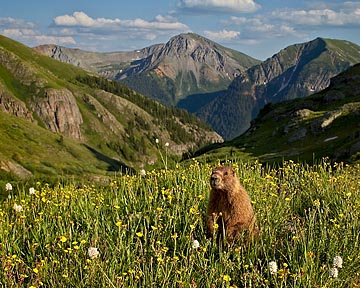
Travel: Banff and Jasper National Parks, Alberta, Canada
I hadn't planned to visit Banff and Jasper National Parks in Canada this year. I had planned to spend most of August and early September in Glacier National Park, but a series of events turned what should have been a great stay into a terrible disappointment. First, the grizzly bears that were so good in 2012 were very scarce, possibly because it was much warmer this year than in 2012. Second, the really convenient, and cheap, boondocking spot I used in 2012 was declared a no-camping zone by the Blackfeet Nation, so I had to move to a real campground and pay $30/night instead of the $10 for up to 12 months like I had planned. (One good thing was that I had cell coverage, and therefore internet access, at the campsite, whereas I didn't at the boondocking spot, and that turned out to be really important for the next problem.) Third, a special website project took a lot longer than I expected to complete and required an unanticipated change of servers where it's hosted. The new server was configured differently than the old server, and it took two days after moving to the new server to get everything on the website functioning properly. Add to that generally rainy conditions, and I was ready to move to a different location. The question was where because I was planning to meet up with Jan in western Colorado to photograph fall color at the end of September. I came up with several places where I could go to more or less kill time until the end of September, then it occurred to me that I could go somewhere that I would really enjoy by popping across the border into Canada and going to Banff and Jasper National Parks. After I finished up the website project I finally had some time to get some needed photography office work done. Shortly after crossing over into Canada, my stress level dropped and by the time I was going by Canmore and making my final approach to Banff, I had a smile on my face. I hadn't felt that good in months. In the first 24 hours I was in Banff National Park, I made more good images than I made during the entire two weeks I was at Glacier!
One of those early images is this one (below L) of a good-sized bull Elk browsing. It's not a terribly exciting image, but he did give me some good behavior by licking his nose. Mistaya Canyon is a fantastic slot canyon where the Mistaya River gets squeezed and thunders through. It's wonderful to look at, but I really enjoy photographing the boulders just upstream. Their arrangement changes every year after the heavy spring runoff so there are always new compositions to find. By using a polarizer to maximize the reflections and a 3-stop solid neutral density filter to lengthen the exposure, I was able to create an image that I knew would work great in black-and-white (below R).
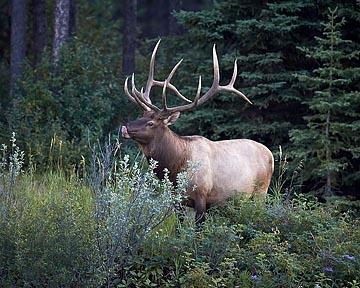
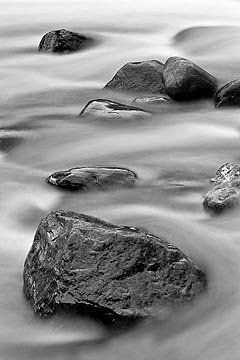
10 sec, f16, ISO 100
I only had one bear sighting, and that was along the road to Maligne Lake in Jasper National Park where I saw a bear jam for what I learned was a Black Bear sow with two cubs that had just disappeared down the hill among the trees. On my way back to the Jeep to leave, I saw some people rushing to another location because the bears had become visible again. They were making their way up closer to road level, so I set up in the Jeep to shoot as they came into a good position and was able to make a couple of good images of the spring cubs as they approached the road before crossing (below L).
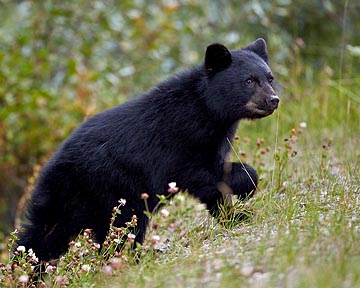
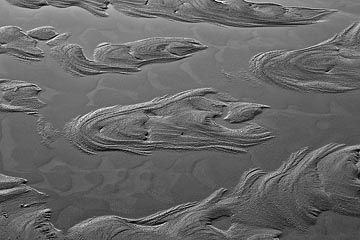
Conditions weren't very good for grand landscape photography when I was in Jasper National Park, so I turned my attention to more intimate scenes. One of the most interesting areas I found was the shallows along Jasper Lake. The very flat sandy shore reminded me of Bandon Beach and Canon Beach in Oregon when the tide is out because the sand was very wet and there were small islands of sand above the waterline (above L). I used a polarizer to maximize the reflections and the tilt motion of the 90mm Tilt/Shift lens to align the plane of focus along the ground. Processing the image in black-and-white helped the forms stand out.
I was looking forward to the elk rut in Jasper and found two big bulls early on but they were never in a good location to photograph them. So, the first images I made were of a slightly smaller bull elk, with a modest 6x6 rack, eating some wildflowers while keeping an eye on his small harem (below L). Two days later, one of the big bulls, with a huge 7x7 rack, was out in a nice location, and here (below R) he's bugling while protecting his large harem.
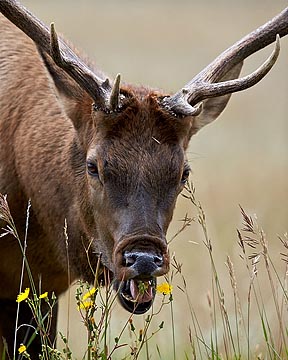
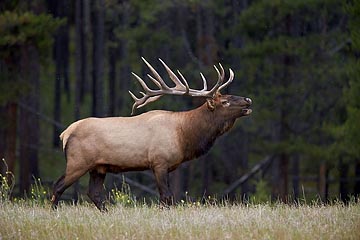
It snowed overnight and into the morning late in my stay in Jasper National Park, so I stuck around a few days until the clouds broke to reveal the beautiful snow-covered mountains. The clouds looked most promising on the west side of the Athabasca River so I went to an area that had some nice boulders that could be used as a foreground. As soon as I saw the snow-covered piece of driftwood on the dark sandy shore, I knew I had found my foreground (below L).

2-stop hard grad ND, 2-stop soft grad ND,
0.7 sec, f13, ISO 100
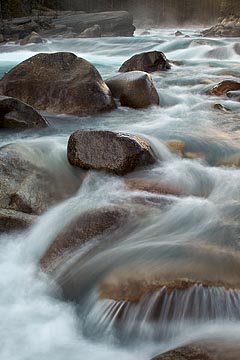
1 sec, f13, ISO 100
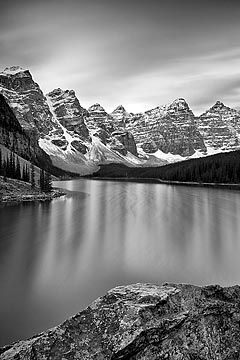
3-stop soft grad ND, 13-stop ND,
4 min 12 sec, f9.5, ISO 100
On my way back south, I stopped at Mistaya Canyon again to photograph the cascades because there were no clouds for an interesting grand landscape image that morning (above C). It was a rather chilly 20°F (-7°C) which created some nice steam above the river and caused water drops to freeze on my tripod legs. I also spent a few more days at Moraine Lake, another of my favorite locations in Banff National Park. I had spent three mornings there on the way north and three morning on the way south before conditions were good enough to make a nice grand landscape image (above R). The clouds weren't terribly interesting and there was no color, plus it was breezy enough that the lake was choppy most of the time so there wasn't much of a reflection. The clouds were moving across the frame, so I used a 10-stop solid neutral density filter and a 3-stop solid neutral density filter to lengthen the exposure to blur the clouds and smooth out the choppy water. I also used a 3-stop soft graduated neutral density filter to balance the dark foreground and bright sky. For such a long exposure, and in general where significant parts of the scene change between the beginning and end of the exposure, exposure bracketing to blend images later isn't very useful.
I'll tell you about the fall color in Colorado next time.
Take care and happy shooting.
— James
James Hager Photography :: www.jameshagerphoto.com




